A loan agreement is a document that outlines the terms between a lender and a borrower regarding a loan. Like a promissory note, it specifies the amount borrowed, the interest rate, and the repayment schedule. However, a loan agreement is typically more comprehensive, often including clauses about collateral, default conditions, and other legal protections for both parties. While a promissory note focuses on the borrower's promise to repay, a loan agreement covers the broader relationship and obligations of both the lender and borrower.
A mortgage is another document that shares similarities with a promissory note. When a borrower takes out a mortgage to buy property, they sign a promissory note to repay the loan, but they also sign a mortgage document that secures the loan with the property itself. The promissory note serves as a promise to pay, while the mortgage provides the lender with the right to take possession of the property if the borrower defaults. This dual structure ensures that both the loan and the collateral are clearly defined.
When dealing with trailer sales, it is important to utilize the correct documentation to streamline the process and ensure compliance with state regulations. The Virginia Trailer Bill of Sale serves this purpose effectively, offering both parties clear evidence of the transaction. For individuals interested in the proper forms to facilitate vehicle transactions, resources such as Auto Bill of Sale Forms can be invaluable in obtaining the right paperwork.
A credit agreement is similar in that it establishes the terms under which a borrower can access credit. Like a promissory note, it details the amount of credit extended, the interest rate, and repayment terms. However, credit agreements often involve revolving credit lines, such as credit cards, where borrowers can draw on the credit as needed. While a promissory note typically represents a single loan transaction, a credit agreement can encompass multiple transactions over time.
An IOU, or informal acknowledgment of debt, is another document that bears resemblance to a promissory note. An IOU indicates that one party owes money to another, but it lacks the formal structure and legal enforceability of a promissory note. While both documents acknowledge a debt, an IOU is often less detailed and may not specify repayment terms or interest rates. This makes it a more casual option, suitable for personal loans among friends or family.
A personal guarantee is similar in that it involves a promise to repay a debt, but it typically involves a third party. When someone signs a personal guarantee, they agree to be responsible for another person’s debt if that person fails to repay it. Like a promissory note, it creates a legal obligation, but it is often used in business contexts where a lender requires additional assurance that the debt will be repaid. This document can provide extra security for lenders, similar to how a promissory note secures the borrower's commitment to repay.
